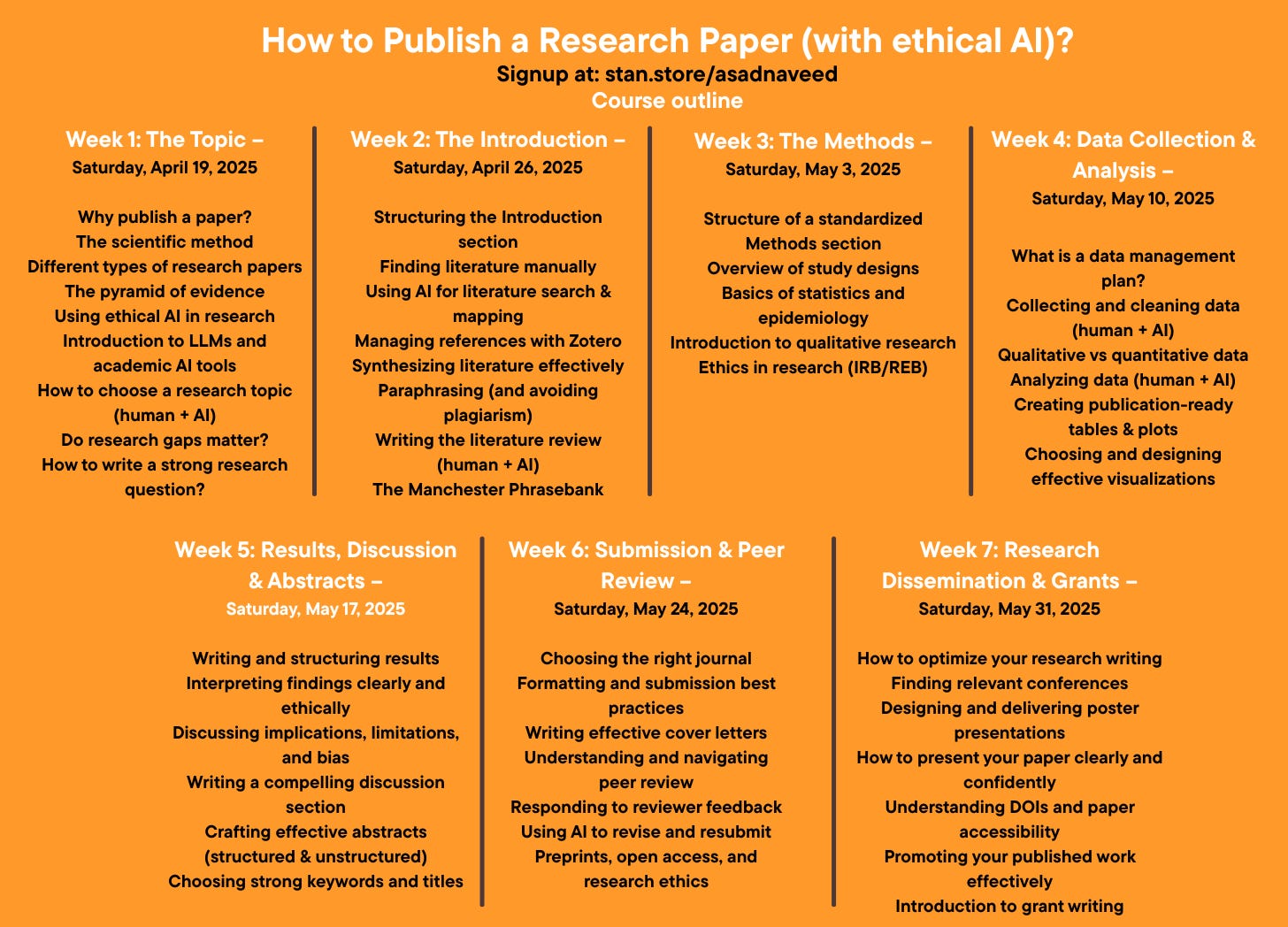This week I’m launching a 7-week course titled: How Publish a Paper (with Ethical AI). The course includes seven webinars (details below) that will run from 19 April 2025 to 31 May 2025 at 11:00 am EST. Learn how to craft a strong research question, collect and analyze data, do a literature review, structure your paper, choose the right journal and navigate peer review. Only a few spots remain. A 9% discount is available to this newsletter’s subscribers. Use code: “an09”. Signup on this link now! #Ad
Hi all!
When using PubMed, Google Scholar, or any literature database, how can you make sure that the keywords you enter will retrieve all the relevant articles you need?
In this newsletter, I'll guide you through the process of crafting an effective literature search strategy and introduce key tools to ensure your search is comprehensive and retrieves all relevant articles.
The strength of a systematic literature search lies in its ability to comprehensively identify and include all relevant studies in literature databases.
Here are the key steps to crafting an effective search strategy:
i. Identify search concepts and terms for each
The first step in a systematic literature search is identifying key concepts. You can streamline this using the PICO framework - Population, Intervention, Comparison, Outcome.
For instance, consider the question: "In elderly patients (P), how effective is the influenza vaccine (I) compared to no vaccine (C) in preventing flu-related hospitalizations (O)?"
Start by identifying essential concepts, focusing on those most likely to be found in the title & abstract.
ii. Controlled Vocabulary in Searches
The next step involves identifying controlled vocabularies for databases.
Controlled vocabularies in systematic literature search are standardized, predefined terms that databases employ to index and retrieve relevant articles, ensuring consistency and overcoming terminology variations across studies.
These vocabularies, like the medical subject headings (MeSH) in PubMed, are organized hierarchically. For instance, if you're researching influenza, using the MeSH term "Influenza, Human" ensures that you capture articles that might refer to the condition as "flu", "seasonal influenza", or even "H1N1".
Encompassing these varied terminologies under one standardized term enhances the precision of your search. Here is a classification of controlled vocabularies across four (4) databases.
iii. Keywords search
When you use keyword searches, you're instructing databases to look for exact matches to the terms you input. This method can be very direct but comes with its own set of challenges:
- Precision: Searching "flu" might miss articles using "influenza".
- Broadness: "Flu" could retrieve unrelated articles, e.g., "fluorescence".
- Variability: Different terms for the same concept require diverse keywords.
For an influenza-focused review, using keywords like "seasonal flu", "H1N1", and "influenza A" ensure you get comprehensive results.
Crafting Keyword Terms for Systematic Literature Search:
Here are a few steps that’ll ensure you craft keywords adequately:
- Identify similar/synonym terms: Capture variations like "flu" and "influenza.
- Identify spelling variations: Consider different regional spellings/ terminologies or hyphenated terms. E.g.: American versus British spelling
- Identify inconsistent descriptions: Some terms might be phrased differently across articles but have the same meaning. E.g., terms like "bird flu" and "avian influenza".
- Specificity Spectrum: Balance between generic and detailed terms. E.g., from "virus" to "H1N1 influenza virus."
- Truncation: Asterisk (*) at the end of a string of characters searches for all terms that begin with that string. E.g., using "influenz*" retrieves "influenza", "influenzae", and "influenzal".
- Wildcards: “?” replace a letter or denote an extra letter where spelling or word variation is possible. E.g. "H?N1" matches both "H1N1" and "H3N1".
- Proximity Operators: "influenza NEAR3 vaccine" ensures articles where "influenza" and "vaccine" are within three words of each other.
Remember, the key is to think broadly, capture all relevant terms, and tailor your search strategy to the specific database in use.
iv. Combine Terms with Boolean Operators
Utilizing Boolean operators enhances the specificity and breadth of your search.
The operator "AND" ensures that all selected concepts are present in the results. For example, "influenza AND vaccine" will retrieve articles containing both terms.
On the other hand, the "OR" operator fetches results where any of the mentioned concepts appear, so "flu OR influenza" captures articles with either term.
If you want to exclude a particular term, the "NOT" operator comes in handy. For instance, "influenza NOT H1N1" will bring up articles on influenza that don't mention the H1N1 strain specifically.
Here is an image to illustrate this concept:
v. Translate Your Search Strategy
Each database, be it PubMed, Scopus, or Web of Science, has its own unique terminology and way of interpreting search queries (syntax). It's essential to adapt your search strategy to fit the specific standards of every database you're using.
Here are some free tools to help you with “search translation" i.e., convert the keyword strategy of one database to another within seconds.
ChatGPT
Example:
vi. Document your Search.
For best practices, transparency, and reproducibility, document all elements of the literature search.
Resources for further reading:
In this quick guide, you've learned the basics of doing a systematic search. Use this as a starting point for deeper research. And remember, always reach out to your librarian for extra help and advice.
In my webinar course, I’ll do a video walkthrough of this process. Here is the full menu if interested in signing up:
Thank you to you all. Have a great weekend ahead!
Best, Asad Naveed








I have been following you for the past three years. Each of your posts offers something new. Thank you very much.
Very Informative. Thank you so much